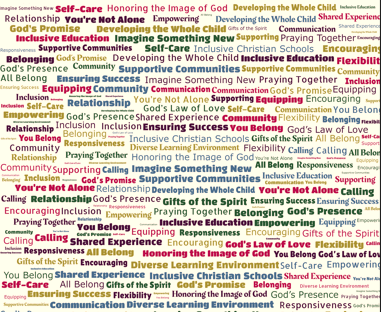One of my best friends in elementary and middle school was a girl named Rachel. We spent hours on the playground with our imaginary dogs, enjoyed several weekly rounds of Oregon Trail on the desktop computer in the back of the classroom, and swam happily all spring and summer in her backyard pool. I was thrilled to be pulled from our regular classroom every month or so during the school year to meet with the school’s inclusive education coordinator, Rachel, and a handful of other students who were close to her. Rachel had Down Syndrome, and we spent those meetings talking about what she was good at, what she could work on, and how we as her peers could support her in the classroom and on the playground.
These meetings, while normal to me, turned out to be a revolutionary act for the early 1990s. Though I didn’t know it, my local Christian school was in the epicenter of a movement in West Michigan whose aim was to make students with disabilities feel included and supported in Christian schools. Those educators were actually turning me, a fairly shy and retiring wallflower, into an agent for inclusion and, eventually, a far more empathetic and competent teacher in my own right.
I continued on to high school in the same district, and I now actually teach there as well. For my entire educational and professional career, I have seen students with disabilities participate fully and richly in classrooms. When I chose this theme for our February issue, I expected stories from teachers with similar experiences. I found it surprising that CEJ hadn’t covered the topic in more than ten years, so I wrote the call for submissions and started with “Christian schools have long been known as welcoming and supportive communities for students with a variety of learning needs.”
It turns out that my experience wasn’t as universal as I expected. I met several months ago with Elizabeth Lucas Dombrowski, the CEO of All Belong Center for Inclusive Education (the organization that pioneered the program I participated in with Rachel as a kid) to talk about some of the existing scholarship on inclusion and gather ideas for this issue. She commented right off the bat that my opening line in the call for submissions (“Christian schools have long been known…”) gave her pause. “Unfortunately, that hasn’t always been true,” she said. I just happened to attend school at the exact time and place where inclusion was becoming a focus.
I’m incredibly grateful for that experience, and I’m indebted to All Belong for their help with this issue and their leadership in inclusive education. In this issue, you’ll find stories from schools and teachers at many different points in their inclusion journey. Elizabeth starts us off with an orientation to inclusion, and then Carolyn Beall tells about her Maryland school’s experience with All Belong. To round out All Belong’s content, Tyler Harms discusses the ways the organization helps train paraeducators.
At the center of this issue, you’ll find a treatise by Wheaton professor of education Thomas Boehm about the biblical foundation for inclusive education. If you or your school are looking for a place to start, this examination of our call as Christians toward inclusivity is a fantastic launchpad.
The issue is rounded out by two pieces focused on what teachers can do each day in their classrooms to create inclusive education spaces. Hayden MacKinnon writes about the ways his own disability has impacted his teaching, and Christine Scholma considers ways that teachers can incorporate self-care (for themselves and students) into their school days in a way that’s approachable for all students.
I hope something in this issue speaks to you or your school’s current state of affairs regarding inclusive education—whatever that may be. Whether you’re just starting to think about what a diverse learning environment might look like or you’ve had years of experience and a robust group of students receiving inclusion services, your work matters to God and to the families you serve. And if you’d like a partner as you do this work, All Belong is there for you—they work with over a hundred schools in the United States and internationally. Find out more at allbelong.org.
